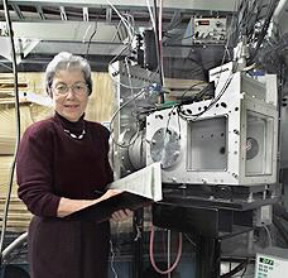Darleane Hoffman (b. 1926)
Darleane Hoffman gained international recognition for capturing and analyzing elusive transuranic elements (elements heavier than uranium) that typically exist for only short periods, making important discoveries about the nature of fission—the atomic process at the heart of nuclear power.
When Hoffman entered Iowa State College (now Iowa State University), she was not on the path to a career in chemistry. Her major was applied art until a professor inspired her to pursue chemistry. She wound up carrying all the way through to earn her Ph.D. from Iowa in 1951. She also met and married Marvin Hoffman while earning her Ph.D. In 1953, the couple took positions at Los Alamos National Laboratory in New Mexico, where she worked on nuclear chemistry and would establish herself as the world authority on spontaneous fission, the sudden decay of heavy nuclei into two "daughter" nuclei.
For years, scientists believed that transuranium elements did not occur in nature until 1971 when Hoffman published her discovery of small amounts of a plutonium isotope (plutonium-244) in a rock formation several billion years old. Hoffman performed a rare study of the chemistry of the transuranium element hahnium, also called dubnium. The study is considered rare because transuranium elements are so radioactive that they quickly decay before they can be studied. Using an isotope called hahnium-262, which has a half-life of only 35 seconds, she was able to study how the element behaved both in aqueous solution and in the gas phase. She studied the same properties of lawrencium-103, which has a half-life of three minutes.
Along the way, Hoffman made a significant discovery about nuclear fission. Scientists had known since the late 1930s that the nuclei of certain elements split when bombarded with neutrons, but in the early 1970s Hoffman discovered that the atoms of one element, fermium, could split spontaneously.
Hoffman left in 1984 to become a professor at the University of California, Berkeley and researcher at the affiliated Lawrence Berkeley National Laboratory. She is also among the researchers who confirmed the existence of Seaborgium, or element 106, a synthetic element whose isotope has a half life of 1.9 minutes.
Hoffman received the National Medal of Science in 1997. In 2000, she became the second woman to receive the Priestley Medal, the American Chemical Society’s highest honor. She is also a recipient of the Society’s Nuclear Chemistry Award (1983) and Francis P. Garvan-John M. Olin Medal (1990).
See more Notable Women Scientists in History
Sources
- Darleane Hoffman. (n.d.). Chemistry in History. Retrieved from http://www.chemheritage.org/discover/chemistry-in-history/themes/atomic-and-nuclear-structure/hoffman.aspx.
- Yarris, Lynn. (2000). Chemists Award Darleane Hoffman Highest Honor in Their Field. Science Beat. Retrieved from http://www.lbl.gov/Science-Articles/Archive/hoffman-priestley.html.
- Darleane Hoffman, Harold Johnston to Receive National Medal of Science. (1997). Berkeley Lab Science Articles Archive. Retrieved from http://www.lbl.gov/Science-Articles/Archive/nat-medal-winners.html.


